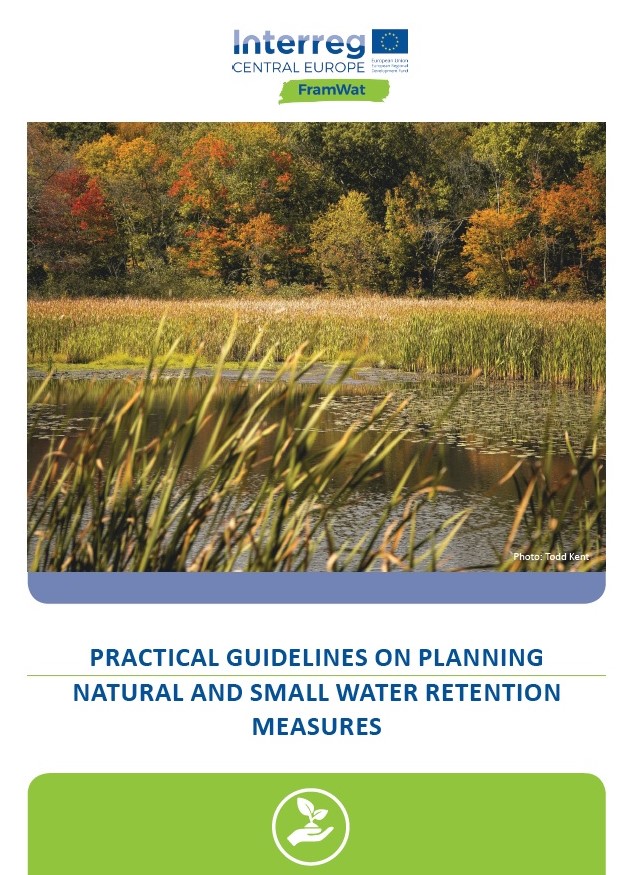Despite the significant progress across Europe towards achieving good ecological and chemical status of freshwaters as required by the EU Water Framework Directive, there is still a lot of work to be done in order to achieve a better status of fauna and flora, as well as favourable hydrological and chemical characteristics. Various types of measures listed under the name Natural (Small) Water Retention Measures (N(S)WRM) can have significant positive effects on solving environmental problems such as hydrological extremes, nutrients’ transport and decreased biodiversity.
FramWat project
The limited implementation of the natural (small) water retention measures (N(S)WRM) across the whole region negatively affects the vulnerability of environmental resources (water, biodiversity and soil) to climate impacts (frequent severe floods and droughts) and man-made pressures. Therefore, nine partners from 6 Central European countries in a framework of the FramWat project (Framework for improving water balance and nutrient mitigation by applying small water retention measures) developed a practical guidance for planning Natural (Small) Water Retention Measures (N(S)WRM) in the river basins.
The main aim of a 3-year long (2017 – 2020) project, funded by Interreg Central Europe, was to support and boost knowledge on more systematic approaches towards the application of N(S)WRM in river basins. Limited integration of N(S)WRM in river basins and flood risk management is primarily a consequence of lack of a knowledge base and tools for planning, assessment, and implementation of the multiple benefits of such measures at the river basin scale. The primary focus of the FramWat project was therefore to increase the skills and capacities of water authorities and the related stakeholders for sustainable use of landscape, and to develop an innovative systematic approach to support the implementation of N(S)WRM.
Step-by-step guide to the application of N(S)WRM in river basins
The Guidelines address the knowledge gap and issues related to the integration of N(S)WRMs into the third cycle of river basin management plans in line with the Water Framework Directive (WFD).
The target groups of the guidelines are decision-makers, experts, and stakeholders, involved in the design and implementation of N(S)WRMs as part of plans and programmes addressing crosscutting water management, climate change, biodiversity, forestry, agriculture, and land use issues.
The added value of the Guidelines is the fact that it is based on the analytical work of the FramWat project and coordinated testing in real pilot catchments in 6 countries in Central Europe. The Guidelines offer a connection with all important outputs developed within the FramWat project, best practices from participating countries, and practical recommendations from pilot catchments through the 5-step process of N(S)WRM planning:

Decision Support System for Planning of Natural (Small) Water Retention Measures
In order to support 5-step approach FramWat partners developed Decision Support System for planning of Natural (Small) Water Retention Measures which introduces and integrates access to different FramWat tools. It was created for people involved in planning water retention measures to mitigate the effects of drought, floods, and surface contamination by biogenes. The goal of the application is to familiarise the user with the catalogue of N(S)WRM and the planning process, as well as to survey their preferences for their area of interest. Part of the DSS is the N(S)WRM planner which facilitates inclusion of local stakeholders’ preferences for planning measures in the field of water retention. It is helpful in data preparation, necessary for developing a concept plan and estimating the investment risk.
“I sincerely believe that implementation of N(S)WRM can have positive effects on water and sediment balance as well as on pollutant retention in river basins and that the tools and guidelines developed by the FramWat project could facilitate more effective flood and river basin management planning at different spatial scales.”
Adam Kovacs
Technical Expert for Pollution Control, ICPDR
New Guidelines are well-timed for decision-makers with appropriate tools to incorporate N(S)WRM into the river basin management plans 2022-2027. They offer guidance and raise awareness of the importance of horizontal integration of different planning frameworks.
Green infrastructure will play a vital role in economic recovery from the coronavirus pandemic. A recently approved recovery instrument offers an opportunity to solve heritage from the past regarding environmental burdens, fix current lack of water supply and sanitation, and look ahead to the implementation of structural reforms, facilitation of innovation, and support of climate-proof solutions. Not all the priorities are directly connected to water, although water is an important connector, particularly with respect to climate change.
The Guidelines highlight the importance of stakeholder involvement and social capital for the successful uptake of N(S)WRMs. The pilot actions benefited from the bottom-up approach and cross-sectoral cooperation of agriculture, forestry, fisheries, tourism, and civil protection sectors.
The Guidelines are among the most important outputs of the FramWat project. They connect and summarise all other outputs in a holistic way. The publication is therefore a must-read for anyone interested in river basin management or land use planning.
Cover Photo: Channels used for small water retention in Nagykunság sub-catchment areah, Hungary (MTDWD)

